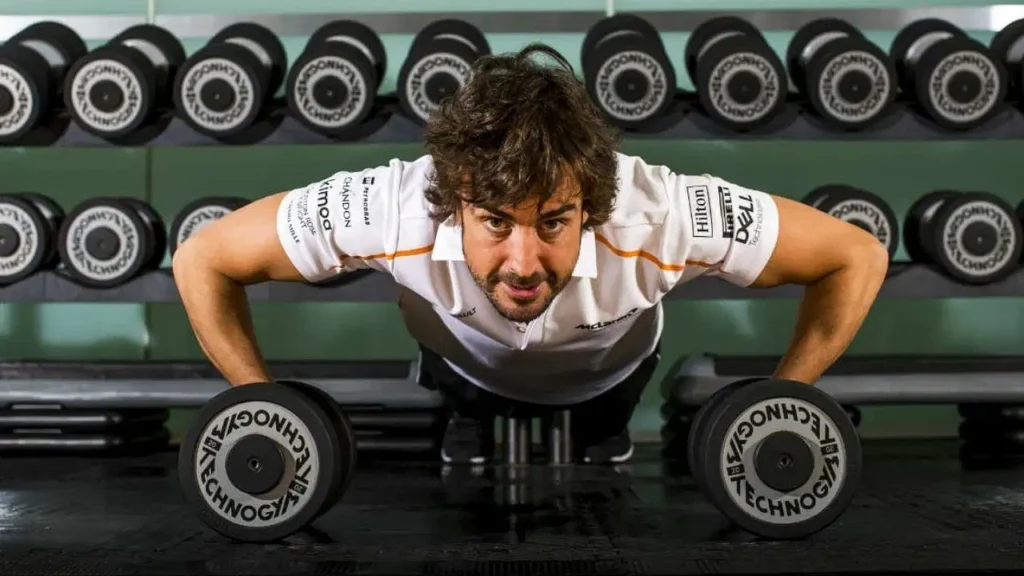Fernando Alonso stands as one of the Formula 1’s most triumphant and beloved figures. With two world championships, 32 race victories, and an impressive 97 podium finishes under his belt, his legacy in the sport is undeniable. Yet, it’s not just his remarkable track record that sets him apart; Alonso is equally renowned for his aggressive and fiercely competitive driving style, coupled with his candid and outspoken personality.
He measures approximately 1.71 meters (5 feet 7 inches) in height and tips the scales at 68 kilograms (150 pounds). Remarkably, these numbers place him squarely in the middle of the current crop of drivers. This seemingly unremarkable height and weight combination, however, holds significance when considering how it impacts his performance on the track. Specifically, it allows him to seamlessly fit into the cockpit of his Formula 1 car without presenting any undue disadvantages concerning the car’s setup or overall performance.
The natural follow-up question is: How does Alonso’s stature compare to that of his fellow Formula 1 drivers, and how does it influence his performance? In the pages that follow, we will delve into these inquiries and uncover the insights they hold.
Fernando Alonso Height and Weight
Fernando Alonso Height
Fernando Alonso is 1.71 meters (5’7″) tall
To see the average f1 driver height follow this link.
Fernando Alonso Weight
Fernando Alonso weighs 68 kilograms (150 lbs.).
To see the average f1 driver weight follow this link.
Comparison The Average F1 Driver Height and Weight

The average height of an F1 driver in 2023 is 1.77 meters (5’10″) and the average weight is 68 kilograms (150 lbs.). However, there is a wide range of variation among the drivers, with some being much taller or shorter, heavier or lighter than others.
- The tallest drivers on the grid are Esteban Ocon and Alexander Albon, who are both 1.86 meters (6’2″) tall.
- The shortest driver is Yuki Tsunoda, who is only 1.59 meters (5’3″) tall.
- The heaviest driver is Nico Hulkenberg, who weighs 78 kilograms (172 lbs.).
- The lightest driver is Tsunoda again, who weighs just 54 kilograms (119 lbs.).
Fernando Alonso height is slightly below the average height and weight of an F1 driver.
He is 1.71 meters (5’7″) tall and weighs 68 kilograms (150 lbs.). This means he is 6 centimeters (2 inches) shorter and has the same weight as the average F1 driver.
Why Height And Weight Matter In Formula 1
Formula 1 is a sport that demands the highest level of physical and mental fitness from its drivers. They have to endure extreme forces of up to 5G, high temperatures, dehydration and fatigue during a race that can last up to two hours.
Height and weight are important factors that influence the driver’s comfort, safety and speed in the car. A taller or heavier driver has to deal with more challenges than a shorter or lighter one. For example:
- A taller driver has less space in the cockpit and may have difficulty fitting in the seat, pedals and steering wheel. This can affect their visibility, posture and ergonomics, which can lead to discomfort, pain and injuries.
- A heavier driver adds more weight to the car, which reduces its performance and fuel efficiency. The car has to carry more fuel, which increases its weight even more. The car also has to brake harder, accelerate slower and corner slower than a lighter car.
- A taller or heavier driver has a higher center of gravity, which affects the car’s balance and stability. The car may be more prone to oversteer or understeer, which can compromise the driver’s control and confidence.
Fernando Alonso Height and Weight – The Impact of Height and Weight on F1 Performance
Height and weight can have a significant impact on F1 performance, especially in terms of lap time and fuel consumption. It is estimated that every extra kilogram of weight can cost around 0.035 seconds per lap.
This means that a driver who weighs 10 kilograms more than another driver could lose around 0.35 seconds per lap, which can add up to several seconds over a race distance.
Similarly, every extra kilogram of weight can increase fuel consumption by around 0.016 liters per lap. This means that a driver who weighs 10 kilograms more than another driver could use around 0.16 liters more fuel per lap, which can affect their strategy and pit stops.
Therefore, it is advantageous for a driver to be as light as possible, without compromising their health and strength.
There Is A Minimum Weight Limit For Each Car
However, there is a minimum weight limit for the car and driver combined, which is set at 752 kilograms for 2023. If the driver is too light the teams are required to add ballast to the car to bring the weight up to the limit.
This means that a lighter driver can add more ballast to their car, which can be placed lower and improve the car’s handling.
Fernando Alonso has a relatively good height and weight for F1 performance. He is not too tall or heavy to cause any major disadvantages in terms of space, speed or fuel efficiency.
Alonso is also not too short or light to require too much ballast in his car. He can optimize his car’s weight distribution and balance to suit his driving style and preferences.
Alonso’s Diet And Fitness Routine

Fernando Alonso is well aware of the importance of height and weight in F1, and he follows a strict diet and fitness routine to maintain his optimal shape. He eats a balanced and healthy diet, with plenty of fruits, vegetables, lean proteins, complex carbohydrates and healthy fats.
The Spanish driver avoids processed foods, refined sugars, alcohol and caffeine. He drinks plenty of water and hydrates himself before, during and after a race.
Alonso also trains hard to improve his strength, endurance, flexibility and coordination. He does a variety of exercises, such as cycling, running, swimming, boxing, yoga and Pilates.
Fernando also works on his core stability, neck muscles, reflexes and reaction time. He trains for several hours a day, six days a week, and adapts his routine to the different demands of each circuit.

Alonso is one of the fittest and most dedicated drivers in F1, and he has shown that he can compete at the highest level despite being 41 years old in 2023.
He has also proven that he can adapt to different cars and teams, having driven for Renault, McLaren, Ferrari and Alpine in his career. He is a true legend of the sport and an inspiration for many aspiring drivers..

